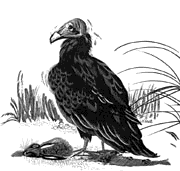Turkey Vultures:
Nature's Cleanup Crew
By Kathy Reshetiloff
Turkey vultures.
They're hard to admire. After all, they eat carrion, defend their
nests by regurgitating, and excrete on themselves. However, they
perform an important yet thankless function. Turkey vultures help
to rid the landscape of road kill and other carcasses. It's even
reflected in their scientific name, Cathartes aura---Cathartes
from the Greek word katharsis meaning to purge or cleanse.
 Turkey
vultures are common from southern Canada, throughout most of the
United States and into South America. Northern birds are migratory,
leaving colder areas in September and October for warmer climates.
Some turkey vultures migrate in flocks while others join up with
more of their kind en route south. Turkey
vultures are common from southern Canada, throughout most of the
United States and into South America. Northern birds are migratory,
leaving colder areas in September and October for warmer climates.
Some turkey vultures migrate in flocks while others join up with
more of their kind en route south.
The turkey vulture is a brownish-black bird with two-tone black
wings and a naked red head. A large bird, the turkey vulture has
a wingspan of nearly 6 feet. Once in the air, the turkey vulture
is quite graceful, soaring for hours on updrafts and rising columns
of warm air called thermals. In flight, a turkey vulture holds
its wings extended into a V-shape, lightly rocking from side to
side. Turkey vultures are able to stay within the thermals by
flying in tight circles.
Their diet consists almost entirely of carrion from fresh to putrid,
although they will occasionally feed on decaying vegetation, insects
or fish. Efficient scavengers, turkey vultures quickly dispose
of carcasses. They can consume the bodies of animals that died
of illness or infection without being adversely affected. They
are most likely to be found soaring over open or semi-open country,
including fields, lightly wooded areas, deserts and foothills.
Turkey vultures often congregate together in areas known as roosts.
They will rest in the largest trees or sit in trees to sun themselves---late
risers, turkey vultures wait for sun to warm them. They pose with
wings slightly drooped, known as a spread wing posture. This helps
dry their wings and regulate their body temperature. Wing spreading
in the morning absorbs solar energy, passively raising temperature
to daytime level.
Since they have no syrinx or voice box, turkey vultures cannot
sing like other birds. Instead, they hiss, grunt and huff.
Now to some of their unsavory habits. Yes, if threatened or disturbed
they will throw up. There are several explanations for why they
do this. Some believe that predators will consume the regurgitated
material and leave the turkey vulture alone, or it may serve to
distract a potential predator. Most believe, however, that it
is simply a defensive reaction caused by fright. Turkey vultures
have one more bad habit: They excrete down their legs. There are
two theories for why they do this: One is that because their excrement
contains so much ammonium it helps to kill bacteria; another theory
is that they do it to help cool themselves.
Despite these characteristics, they do have redeeming qualities.
Pairs are monogamous, and both parents incubate the eggs, as well
as feed and care for the young. Nest sites consist of little or
no nest at all, and eggs are laid on debris inside a hollow tree
or log, in crevices on cliffs, and in caves, dense thickets or
old buildings.
Usually two whitish eggs, blotched with brown and lavender, are
laid. Incubation lasts 34-41 days, and young are born with a coat
of down and eyes open but must be fed by parents by regurgitation.
If the nest is disturbed, parents will protect it by violent vomiting.
Immature turkey vultures look similar to their parents except
they have black heads and beaks. The young are able to fly at
about 9-10 weeks old, and their beaks turn to adult white or ivory
by the age of four.
Though they may not be on your list of favorite birds, turkey
vultures do help to recycle carcasses quickly. With the increase
in development, there are undoubtedly more road kills. Scavengers
like turkey vultures keep the surrounding environment clear of
unsightly and decaying animal bodies. So, remember that when you
see one circling overhead, in the absence of vultures, every day
would be like a garbage strike.
Kathryn Reshetiloff is employed by the Fish and Wildlife Service, U.S. Department of the Interior. Illustration by Robert Savannah, U.S. Fish & Wildlife Service.
|
Back
|

